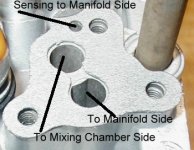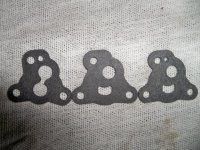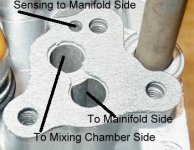I am currently chasing a poor vacuum issue, and along my path am into the bypass valves on the carbs.
1976 TR6 Vac retard.
I am a bit confused as the gasket that mounts the bypass valve to the carburetor has a section missing between the two ports?
I understand that:
There is a signal port (the tiny one), A port on the manifold side of the throttle plate, and a port on the Carb side of the plate. When the manifold depression exceeds the setting the valve floats and allows more air from the carb to the manifold side...
I seem to have old gaskets that have the bridge between the two larger ports, yet I also seem to have some without, which makes no sense to me as there would be a constant leak across this gap.
(In looking at the Moss Kit, it seems to provide both?)
Does anybody have any insight?
1976 TR6 Vac retard.
I am a bit confused as the gasket that mounts the bypass valve to the carburetor has a section missing between the two ports?
I understand that:
There is a signal port (the tiny one), A port on the manifold side of the throttle plate, and a port on the Carb side of the plate. When the manifold depression exceeds the setting the valve floats and allows more air from the carb to the manifold side...
I seem to have old gaskets that have the bridge between the two larger ports, yet I also seem to have some without, which makes no sense to me as there would be a constant leak across this gap.
(In looking at the Moss Kit, it seems to provide both?)
Does anybody have any insight?

 Hi Guest!
Hi Guest!

 smilie in place of the real @
smilie in place of the real @
 Pretty Please - add it to our Events forum(s) and add to the calendar! >>
Pretty Please - add it to our Events forum(s) and add to the calendar! >> 




